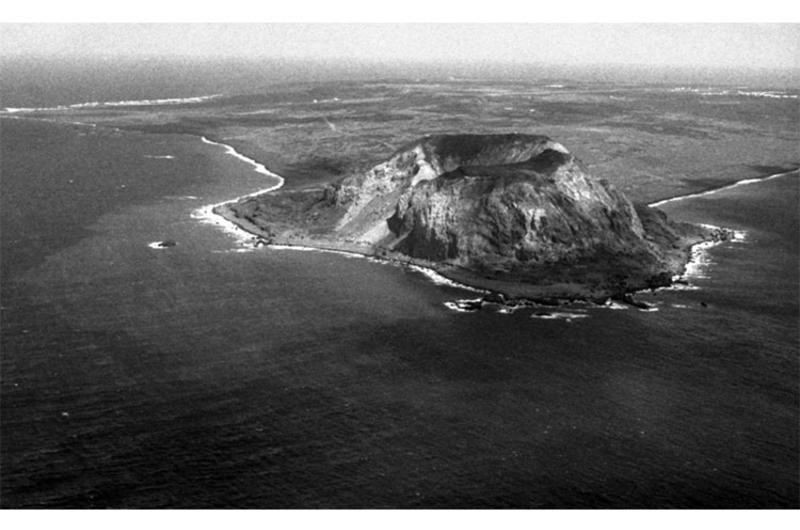Flag raiser's return to Iwo Jima: 'It all seems impossible'

Mount Suribachi, as seen from a plane carrying Iwo Jima flag raiser Rene Gagnon and his family to the island in February, 1965.
By Hal Drake | Stars and Stripes February 21, 1965
IWO JIMA — "It seems impossible that I climbed that far," said Rene Gagnon as he looked down the rugged face of Mount Suribachi.
He is one of the only two survivors in the monumental picture of the Iwo Jima flag raising.
Gagnon walked a short way down a shallow, weed-choked gully that twisted across the 550-foot height, which overlooks 3,000 yards of open beach and made Japanese defenders "king of the mountain" when thousands of U.S. marines poured ashore 20 years ago Friday (Feb. 19). For three days, the living lay with the dead and wounded, until the invaders cracked the defenses around Suribachi and began inching toward the crest.
Gagnon did indeed go "that far." Twenty years ago next Tuesday, he was ordered to carry flamethrowers and radio parts to a patrol that was close to the dead volcano's jagged crest. Using the steep gully for cover, Gagnon ran and crawled through an inferno of artillery and mortar fire.
He somehow made it, and stood on Suribachi's rock-strewn crest minutes after it was taken. A few minutes later, he and Navy Pharmacist's Mate John H. Bradley helped four other men raise a teetering makeshift flagpole.
Associated Press photographer Joe Rosenthal tripped his shutter; the result was an inspiring classic in war photography, one that has been majestically recreated in bronze for the 76-foot-high Marine Corps Memorial in Washington, D.C.
Gagnon returned to Iwo Jima Friday, going out of his way on a luxurious vacation to visit this eight square miles of barren, rocky nothingness. More than that, he brought his wife and 17-year-old son, Rene Jr., to share his memories — and to share both his curiosity and satisfaction. He wanted to see what Iwo looked like now, and was surprised to see the dead land he knew covered by a shroud of foliage. And, too, he wanted "the feeling of standing on my two feet and walking upright across it, without being afraid." No man did this in February, 1945.
The 39-year-old airlines ticket agent from Bedford, Mass., got a free trip from his company that took him as far as Tokyo. From there, as guests of the U.S. military, Gagnon, his wife and son were flown to Iwo where he met other men with similar memories; 31 other marines and ex-marines — all Iwo veterans — came from military posts and civilian jobs throughout the Pacific and Far East. They all stood together for a simple, impressive ceremony atop Mount Suribachi.
Two American military commanders paid tribute to the fallen dead on Iwo — and had messages of friendship for former enemies. Rear Adm. Horace V. Bird, commander Naval Forces Marianas, praised the valor of the defending Japanese as well as the invading Americans and said that today "the United States and Japan stand together."
"From the holocaust of Iwo Jima," added Brig. Gen. John P. Coursey, assistant commander of the 1st Marine Aircraft Wing, "has come not bitterness and hatred, but a fusion, an understanding and a friendship between two great nations and the people of those nations who once faced each other in a titanic war."
It was a brief trip; there was the memorial ceremony, followed by a swift tour of shattered, mouldering old concrete bunkers that overlook the shoreline and other points of interest. The Gagnons returned to Tokyo Friday evening and planned to leave soon for Hong Kong.



